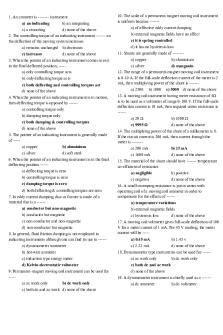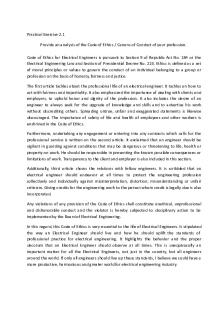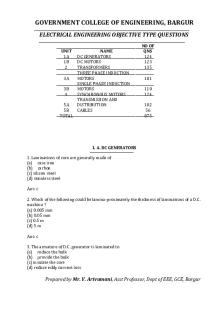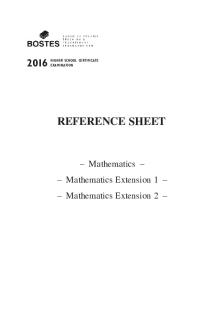Electrical engineering - Wikipedia PDF

| Title | Electrical engineering - Wikipedia |
|---|---|
| Author | Narasimha Nandula |
| Course | Electronic and Communication Engineering |
| Institution | Osmania University |
| Pages | 18 |
| File Size | 1 MB |
| File Type | |
| Total Downloads | 116 |
| Total Views | 167 |
Summary
Download Electrical engineering - Wikipedia PDF
Description
10/11/2018
Electrical engineering - Wikipedia
Electrical engineering Electrical engineering is a professional engineering discipline that generally deals with the study and application of electricity, electronics, and electromagnetism. This field first became an identifiable occupation in the later half of the 19th century after commercialization of the electric telegraph, the telephone, and electric power distribution and use. Subsequently, broadcasting and recording media made electronics part of daily life. The invention of the transistor, and later the integrated circuit, brought down the cost of electronics to the point they can be used in almost any household object. Electrical engineering has now subdivided into a wide range of subfields including electronics, digital computers, computer engineering, power
Some electrical engineers design complex power systems on a macroscopic level.
engineering, telecommunications, control systems, robotics, radio-frequency engineering, signal processing, instrumentation, and microelectronics. Many of these subdisciplines overlap with other engineering branches, spanning a huge number of specializations such as hardware engineering, power electronics,
electromagnetics
&
waves,
microwave
engineering,
nanotechnology, electrochemistry, renewable energies, mechatronics, electrical materials science, and much more. See glossary of electrical and electronics engineering. Electrical engineers typically hold a degree in electrical engineering or electronic
engineering.
Practicing
engineers
may
have
professional
certification and be members of a professional body. Such bodies include the Institute of Electrical and Electronics Engineers (IEEE) and the Institution of Engineering and Technology (IET) (formerly the IEE).
Electrical engineers also design microscopic electronic devices and electronic circuitry, which achieved the record setting length of 1 nanometer for a single logic gate.[1]
Electrical engineers work in a very wide range of industries and the skills required are likewise variable. These range from basic circuit theory to the management skills required of a project manager. The tools and equipment that an individual engineer may need are similarly variable, ranging from a simple voltmeter to a top end analyzer to sophisticated design and manufacturing software.
Contents History 19th century More modern developments Solid-state electronics Subdisciplines Power Control Electronics https://en.wikipedia.org/wiki/Electrical engineering
1/18
10/11/2018
Electrical engineering - Wikipedia
Microelectronics Signal processing Telecommunications Instrumentation Computers Related disciplines Education Practicing engineers Tools and work See also Notes References Further reading External links
History Electricity has been a subject of scientific interest since at least the early 17th century. William Gilbert was a prominent early electrical scientist, and was the first to draw a clear distinction between magnetism and static electricity. He is credited with establishing the term "electricity".[2] He also designed the versorium: a device that detects the presence of statically charged objects. In 1762 Swedish professor Johan Carl Wilcke invented a device later named electrophorus that produced a static electric charge. By 1800 Alessandro Volta had developed the voltaic pile, a forerunner of the electric battery
19th century In the 19th century, research into the subject started to intensify. Notable developments in this century include the work of Georg Ohm, who in 1827 quantified the relationship between the electric current and potential difference in a conductor, of Michael Faraday (the discoverer of electromagnetic induction in 1831), and of James Clerk Maxwell, who in 1873 published a unified theory of electricity and magnetism in his treatise Electricity and Magnetism.[3] Electrical engineering became a profession in the later 19th century. Practitioners had created a global electric telegraph network and the first professional electrical engineering institutions were founded in the UK and USA to support the new discipline. Although it is impossible to precisely pinpoint a first electrical engineer, Francis Ronalds stands ahead of the field, who created the first working electric telegraph system in 1816 and documented his vision of how the world could be transformed by electricity.[4][5] Over 50 years later, he joined the new Society of Telegraph Engineers (soon to be renamed the Institution of Electrical Engineers) where
The discoveries of Michael Faraday formed the foundation of electric motor technology
he was regarded by other members as the first of their cohort.[6] By the end of the 19th century, the world had been forever changed by the rapid communication made possible by the engineering development of land-lines, submarine cables, and, from about 1890, wireless telegraphy.
https://en.wikipedia.org/wiki/Electrical engineering
2/18
10/11/2018
Electrical engineering - Wikipedia
Practical applications and advances in such fields created an increasing need for standardised units of measure. They led to the international standardization of the units volt, ampere, coulomb, ohm, farad, and henry. This was achieved at an international conference in Chicago in 1893.[7] The publication of these standards formed the basis of future advances in standardisation in various industries, and in many countries, the definitions were immediately recognized in relevant legislation.[8] During these years, the study of electricity was largely considered to be a subfield of physics since the early electrical technology was considered electromechanical in nature. The Technische Universität Darmstadt founded the world's first department of electrical engineering in 1882. The first electrical engineering degree program was started at Massachusetts Institute of Technology (MIT) in the physics department under Professor Charles Cross, University to produce the world's first electrical engineering graduates in
1885.[10]
[9]
though it was Cornell
The first course in electrical
engineering was taught in 1883 in Cornell’s Sibley College of Mechanical Engineering and Mechanic Arts.[11] It was not until about 1885 that Cornell President Andrew Dickson White established the first Department of Electrical Engineering in the United States.[12] In the same year, University College London founded the first chair of electrical engineering in Great Britain.[13] Professor Mendell P. Weinbach at University of Missouri soon followed suit by establishing the electrical engineering department in 1886.[14] Afterwards, universities and institutes of technology gradually started to offer electrical engineering programs to their students all over the world.
Thomas Edison, electric
Károly
Zipernowsky,
light and (DC) power Ottó Bláthy, Miksa Déri,
Nikola Tesla, practical Mikhail (AC)
Stanley,
transformers
Dolivo-
and Dobrovolsky developed
induction motor designs
Jr., Galileo
Ferraris,
electrical
theory,
induction motor
the ZBD transformer
supply networks
polyphase
William
Charles Steinmetz,
Proteus Oliver
Heaviside,
AC developed
standard 3-phase (AC)
mathematical
theories models
systems
for engineers
circuits
theoretical for
electric
During these decades use of electrical engineering increased dramatically. In 1882, Thomas Edison switched on the world's first large-scale electric power network that provided 110 volts — direct current (DC) — to 59 customers on Manhattan Island in New York City. In 1884, Sir Charles Parsons invented the steam turbine allowing for more efficient electric power generation. Alternating current, with its ability to transmit power more efficiently over long distances via https://en.wikipedia.org/wiki/Electrical engineering
3/18
10/11/2018
Electrical engineering - Wikipedia
the use of transformers, developed rapidly in the 1880s and 1890s with transformer designs by Károly Zipernowsky, Ottó Bláthy and Miksa Déri (later called ZBD transformers), Lucien Gaulard, John Dixon Gibbs and William Stanley, Jr.. Practical AC motor designs including induction motors were independently invented by Galileo Ferraris and Nikola Tesla and further developed into a practical three-phase form by Mikhail Dolivo-Dobrovolsky and Charles Eugene Lancelot Brown.[15] Charles Steinmetz and Oliver Heaviside contributed to the theoretical basis of alternating current engineering.[16][17] The spread in the use of AC set off in the United States what has been called the War of Currents between a George Westinghouse backed AC system and a Thomas Edison backed DC power system, with AC being adopted as the overall standard.[18]
More modern developments During the development of radio, many scientists and inventors contributed to radio technology and electronics. The mathematical work of James Clerk Maxwell during the 1850s had shown the relationship of different forms of electromagnetic radiation including possibility of invisible airborne waves (later called "radio waves"). In his classic physics experiments of 1888, Heinrich Hertz proved Maxwell's theory by transmitting radio waves with a spark-gap transmitter, and detected them by using simple electrical devices. Other physicists experimented with these new waves and in the process developed devices for transmitting and detecting them. In 1895, Guglielmo Marconi began work on a way to adapt the known methods of transmitting and detecting these "Hertzian waves" into a purpose built commercial wireless telegraphic system. Early on, he sent wireless signals over a distance of one and a half miles. In Guglielmo Marconi known for his pioneering work on long distance radio transmission
December 1901, he sent wireless waves that were not affected by the curvature of the Earth. Marconi later transmitted the wireless signals across the Atlantic between Poldhu, Cornwall, and St. John's, Newfoundland, a distance of 2,100 miles (3,400 km).[19] In 1897, Karl Ferdinand Braun introduced the cathode ray tube as part of an
oscilloscope, a crucial enabling technology for electronic television.[20] John Fleming invented the first radio tube, the diode, in 1904. Two years later, Robert von Lieben and Lee De Forest independently developed the amplifier tube, called the triode.[21] In 1920, Albert Hull developed the magnetron which would eventually lead to the development of the microwave oven in 1946 by Percy Spencer.[22][23] In 1934, the British military began to make strides toward radar (which also uses the magnetron) under the direction of Dr Wimperis, culminating in the operation of the first radar station at Bawdsey in August 1936.[24] In 1941, Konrad Zuse presented the Z3, the world's first fully functional and programmable computer using electromechanical parts. In 1943, Tommy Flowers designed and built the Colossus, the world's first fully functional, electronic, digital and programmable computer.[25] In 1946, the ENIAC (Electronic Numerical Integrator and Computer) of John Presper Eckert and John Mauchly followed, beginning the computing era. The arithmetic performance of these machines allowed engineers to develop completely new technologies and achieve new objectives, including the Apollo program which culminated in landing astronauts on the Moon.[26]
Solid-state electronics
https://en.wikipedia.org/wiki/Electrical engineering
4/18
10/11/2018
Electrical engineering - Wikipedia
The invention of the transistor in late 1947 by William Shockley, John Bardeen, and Walter Brattain of the Bell Telephone Laboratories opened the door for more compact devices and led to the development of the integrated circuit in 1958 by Jack Kilby and independently in 1959 by Robert Noyce.[27] The microprocessor was introduced with the Intel 4004. It began with the "Busicom Project"[28] as Masatoshi Shima's three-chip CPU design in 1968,[29][28] before Sharp's Tadashi Sasaki conceived of a single-chip CPU design, which he discussed with Busicom and Intel in 1968.[30] The Intel 4004 was then developed as a single-chip microprocessor from 1969 to 1970, led by Intel's Marcian Hoff and Federico Faggin and Busicom's Masatoshi Shima.[28] The microprocessor led to the development of microcomputers and personal
A replica of the first working transistor.
computers, and the microcomputer revolution.
Subdisciplines Electrical engineering has many subdisciplines, the most common of which are listed below. Although there are electrical engineers who focus exclusively on one of these subdisciplines, many deal with a combination of them. Sometimes certain fields, such as electronic engineering and computer engineering, are considered separate disciplines in their own right.
Power Power engineering deals with the generation, transmission, and distribution of electricity as well as the design of a range of related devices.[31] These include transformers, electric generators, electric motors, high voltage engineering, and power electronics. In many regions of the world, governments maintain an electrical network called a power grid that connects a variety of generators together with users of their energy. Users purchase electrical energy from the grid, avoiding the costly exercise of having to generate their own. Power engineers may work on the design and maintenance of the power grid as well as the power systems that connect to it.[32] Such systems are called on-grid
Power pole
power systems and may supply the grid with additional power, draw power from the grid, or do both. Power engineers may also work on systems that do not connect to the grid, called off-grid power systems, which in some cases are preferable to on-grid systems. The future includes Satellite controlled power systems, with feedback in real time to prevent power surges and prevent blackouts.
Control Control engineering focuses on the modeling of a diverse range of dynamic systems and the design of controllers that will cause these systems to behave in the desired manner.[33] To implement such controllers, electrical engineers may use electronic circuits, digital signal processors, microcontrollers, and programmable logic controllers (PLCs). Control engineering has a wide range of applications from the flight and propulsion systems of commercial airliners to the cruise control present in many modern automobiles.[34] It also plays an important role in industrial automation. Control engineers often utilize feedback when designing control systems. For example, in an automobile with cruise control the vehicle's speed is continuously monitored and fed back to the system which adjusts the motor's power output accordingly. Where there is regular feedback, control theory can be used to determine how the system responds to such https://en.wikipedia.org/wiki/Electrical engineering
5/18
10/11/2018
Electrical engineering - Wikipedia
feedback.[35]
Electronics Electronic engineering involves the design and testing of electronic circuits that use the properties of components
such
as
resistors,
capacitors, inductors, diodes, and transistors to achieve a particular functionality.[32] The tuned circuit, which allows the user of a radio to Electronic components
Control systems play a critical role in spaceflight.
filter out all but a single station, is just one example of such a circuit. Another example to research is a pneumatic
signal conditioner. Prior to the Second World War, the subject was commonly known as radio engineering and basically was restricted to aspects of communications and radar, commercial radio, and early television.[32] Later, in post war years, as consumer devices began to be developed, the field grew to include modern television, audio systems, computers, and microprocessors. In the mid-to-late 1950s, the term radio engineering gradually gave way to the name electronic engineering. Before the invention of the integrated circuit in 1959,[36] electronic circuits were constructed from discrete components that could be manipulated by humans. These discrete circuits consumed much space and power and were limited in speed, although they are still common in some applications. By contrast, integrated circuits packed a large number—often millions—of tiny electrical components, mainly transistors,[37] into a small chip around the size of a coin. This allowed for the powerful computers and other electronic devices we see today.
Microelectronics Microelectronics engineering deals with the design and microfabrication of very small electronic circuit components for use in an integrated circuit or sometimes for use on their own as a general electronic component.[38] The most common microelectronic components are semiconductor transistors, although all main electronic components (resistors, capacitors etc.) can be created at a microscopic level. Nanoelectronics is the further scaling of devices down to nanometer levels. Modern devices are already in the nanometer regime, with below 100 nm processing having been standard since around 2002.[39]
Microprocessor
Microelectronic components are created by chemically fabricating wafers of semiconductors such as silicon (at higher frequencies, compound semiconductors like gallium arsenide and indium phosphide) to obtain the desired transport of electronic charge and control of current. The field of microelectronics involves a significant amount of chemistry and material science and requires the electronic engineer working in the field to have a very good working knowledge of the effects of quantum mechanics.[40]
Signal processing https://en.wikipedia.org/wiki/Electrical engineering
6/18
10/11/2018
Electrical engineering - Wikipedia
Signal processing deals with the analysis and manipulation of signals.[41] Signals can be either analog, in which case the signal varies continuously according to the information, or digital, in which case the signal varies according to a series of discrete values representing the information. For analog signals, signal processing may involve the amplification and filtering of audio signals for audio equipment or the modulation and demodulation of signals for telecommunications. For digital signals, signal processing may A Bayer filter on a CCD requires signal processing to get a red, green, and blue value at each pixel.
involve the compression, error detection and error correction of digitally sampled signals.[42] Signal Processing is a very mathematically oriented and intensive area forming the core of digital signal processing and it is rapidly expanding with new
applications in every field of electrical engineering such as communications, control, radar, audio engineering, broadcast engineering, power electronics, and biomedical engineering as many already existing analog systems are replaced with their digital counterparts. Analog signal processing is still important in the design of many control systems. DSP processor ICs are found in every type of modern electronic systems and products including, SDTV | HDTV sets,[43] radios and m...
Similar Free PDFs

Electrical engineering - Wikipedia
- 18 Pages
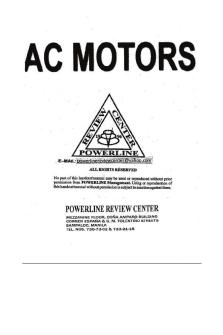
AC Motors101 Electrical Engineering
- 17 Pages
Popular Institutions
- Tinajero National High School - Annex
- Politeknik Caltex Riau
- Yokohama City University
- SGT University
- University of Al-Qadisiyah
- Divine Word College of Vigan
- Techniek College Rotterdam
- Universidade de Santiago
- Universiti Teknologi MARA Cawangan Johor Kampus Pasir Gudang
- Poltekkes Kemenkes Yogyakarta
- Baguio City National High School
- Colegio san marcos
- preparatoria uno
- Centro de Bachillerato Tecnológico Industrial y de Servicios No. 107
- Dalian Maritime University
- Quang Trung Secondary School
- Colegio Tecnológico en Informática
- Corporación Regional de Educación Superior
- Grupo CEDVA
- Dar Al Uloom University
- Centro de Estudios Preuniversitarios de la Universidad Nacional de Ingeniería
- 上智大学
- Aakash International School, Nuna Majara
- San Felipe Neri Catholic School
- Kang Chiao International School - New Taipei City
- Misamis Occidental National High School
- Institución Educativa Escuela Normal Juan Ladrilleros
- Kolehiyo ng Pantukan
- Batanes State College
- Instituto Continental
- Sekolah Menengah Kejuruan Kesehatan Kaltara (Tarakan)
- Colegio de La Inmaculada Concepcion - Cebu

